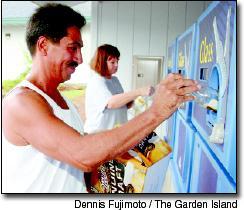That Kaua‘i may or may not have eclipsed the one-million-visitor mark last year doesn’t really matter too much to Sue Kanoho, executive director of the Kaua‘i Visitors Bureau.
Because visitor expenditures and length of stay were both up in 2004 compared to 2003, the number of visitors isn’t as crucial a figure as it once was, she explained.
“That’s not a bad thing” if Kaua‘i didn’t break the million-visitor barrier last year, Kanoho said. The number of arrivals is not as telling a statistic as the length of stay and expenditures, she said. “I think that on the whole 2004 was a great year,” she said.
“It really was a successful year for us,” Kanoho said of 2004.
Even though final figures won’t be available until later this month, the figures available through the end of November were enough for Kanoho to conclude that, based on the figures and what KVB members told her about their 2004s, last year was a very good year for the visitor industry.
Summer 2004 marked the visitor triple peak in terms of arrivals, length of stay and average daily expenditures, she said.
The new year started out with concerns about rotten weather, which sometimes are reflected in dips in arrivals six or eight weeks down the line, said Kanoho.
The 2005 outlook remains sunny, though, she said. “I do feel it will be positive and strong,” she said of summer 2005. Recent history has shown that marketers have been successful in filling in periods of lower visitor arrivals, known as “shoulder” periods, she said.
Those same marketers are already focusing their efforts on the fall of this year, Kanoho continued. Where the cruise-ship industry is concerned, 2005 will be very busy at Nawiliwili Harbor, with leaders of cruiseship companies and state Department of Transportation Harbors Division leaders bracing for 2006, when the island is expected to greet on average at least one cruise ship a day, she said. “We have to be careful to accommodate the sugar ships and Matson (barges),” Kanoho said.
“The Harbors Division has been working hard to do what’s right for passengers and business people,” and the island is “fortunate to have Bob Crowell as harbormaster,” someone who knows the importance of striking that balance, she added.
Commenting on the November arrival statistics from the state Department of Business, Economic Development & Tourism, Margy Parker, executive director of the Po‘ipu Beach Resort Association, noted continued softness in international arrivals to Kaua‘i, while numbers of visitors from the U.S. West (west of the Rockies) and U.S. East (east of the Rockies) were both up.
“We might be popping just over one million if December is (was) an average. It’s going to be very close if December trends like last year,” said Parker.
Both Christmas and New Year’s Day falling on weekends meant two full weeks of peak-holiday visitors in late 2004 and early 2005, Parker said. Arrival figures were likely boosted by the addition of a second, daily, American Airlines nonstop flight from Los Angeles to Lihu‘e, something that started Dec. 15 and will continue indefinitely, she said. “’05 looks like we’re going to have a fairly strong winter, as usual,” though tracking for the spring, summer and fall are not solid yet. Visitors to Hawai‘i typically do not book their island vacations as far in advance as they used to, she said.
At times when akamai (smart) visitors know fares will be high, or when flights are likely to be crowded, they’ll book further in advance, Parker observed.
The “sophisticated traveler” will look for “soft” or “shoulder” periods when there may be airfare, accommodations or other specials at lower prices, she said. The announcement of an early-January fare sale on United Airlines, the carrier that brings the most Mainland visitors to the state, surprised Parker, she admitted.
Why officials at the carrier would reduce fares during this peak travel time is beyond her, she said.
Alas, outbound Hawai‘i travelers didn’t see any fare savings available.
Sandi Kato-Klutke, president of both the Kaua‘i chapter of the Hawaii Hotel & Lodging Association and Kauai Business Council, said hotels did well in 2004, though the condominium side was “flat.” “Some properties did have (occupancy increases), and some didn’t,” though all enjoyed revenue increases in terms of average daily room rates, even the flat condo side, she said. “’05 is definitely looking much better. ‘05 is looking good, based on first-quarter” bookings, said Kato-Klutke, who is also a member of the Kaua‘i Planning Commission.
Paul C. Curtis, associate editor, may be reached at 245-3681 (ext. 224) or pcurtis@pulitzer.net.


